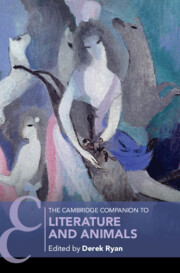Book contents
- The Cambridge Companion to Literature and Animals
- The Cambridge Companion to Literature and Animals
- Copyright page
- Contents
- Figures
- Contributors
- Introduction
- Part I Literary Periods
- Part II Contexts and Controversies
- Chapter 8 Religion
- Chapter 9 Anthropomorphism
- Chapter 10 Habitat
- Chapter 11 Captivity
- Chapter 12 Indigeneity
- Chapter 13 Biocentrism
- Chapter 14 Health
- Select Bibliography
- Index
- Cambridge Companions To …
Chapter 9 - Anthropomorphism
Violence and Law
from Part II - Contexts and Controversies
Published online by Cambridge University Press: 26 October 2023
- The Cambridge Companion to Literature and Animals
- The Cambridge Companion to Literature and Animals
- Copyright page
- Contents
- Figures
- Contributors
- Introduction
- Part I Literary Periods
- Part II Contexts and Controversies
- Chapter 8 Religion
- Chapter 9 Anthropomorphism
- Chapter 10 Habitat
- Chapter 11 Captivity
- Chapter 12 Indigeneity
- Chapter 13 Biocentrism
- Chapter 14 Health
- Select Bibliography
- Index
- Cambridge Companions To …
Summary
This chapter argues that two works of Victorian children’s literature – Alfred Elwes’s The Adventures of a Bear (1853) and The Adventures of a Dog (1854) – capture the complex politics of selfhood in relation to animality and law. They also demonstrate the trope of transformation from animal to human: the dog becomes a trusted policeman (or equivalent) and the bear ends up a blind beggar. In both cases, the choice of animals as protagonists allows for a frank discussion of violence, gender, and class conflict.
- Type
- Chapter
- Information
- The Cambridge Companion to Literature and Animals , pp. 170 - 184Publisher: Cambridge University PressPrint publication year: 2023

